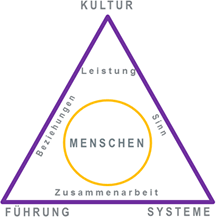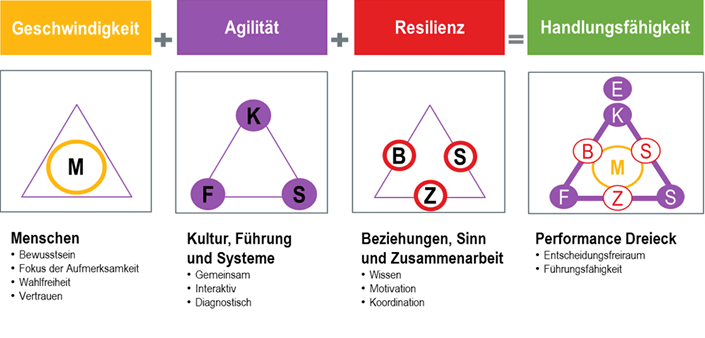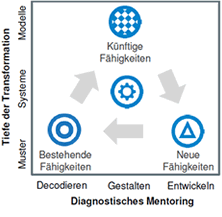3. February 2017

The demands on organisations are growing steadily, while the private and business world is becoming more complex and increasingly less predictable. As the recent past has clearly shown, we are challenged daily by issues which are always good for surprises: not only digitalisation as one of the big drivers, but also other trends, such as urbanisation, progressive globalisation, environmental issues and political developments.
Many companies are rather ill-prepared for these developments and do not adequately use their own potential or the knowledge of employees who are, in fact, highly qualified. Very often, they continue with previously successful behaviour and react to new requirements with known patterns. Above all, management still largely uses methods which originated in the industrial age and are often not suited to meet the new requirements. Although the insight is fundamentally there and this is repeatedly confirmed at many of the countless conferences, in reality, little has changed so far, and if so, then rather slowly.
Why is that? Why is this existing knowledge not translated to the extent necessary? The answer is relatively simple: classical management principles have been successful in the old world for many decades. To replace or change them would mean entering upon unknown terrain and taking a risk. This leads to great uncertainty, particularly for organisations that have grown over many years. After all, there is an existing business that should not be placed in danger. Where and how do we start?
Experience shows that either detailed knowledge about the condition of one’s own organisation is very often lacking, or the assessments and pictures diverge considerably at the upper management level. Often, there is also a lack of information regarding where a successful intervention can be put in place, or there are negative experiences with change projects which are rather ineffective in the end. Management development, insofar as it exists as a solid element, often fails to achieve the desired effect, which is then a clear signal for missed or inadequate implementation measures. Causes and connections between these often observed effects are complex and mostly not obvious at first sight.
In an increasingly dynamic (VUCA-) environment, where corporate management is becoming more and more demanding, established recipes and procedures, which are often still based on stable and (therefore) more predictable times, are rather bad. Or they are completely ineffective because they provide the wrong answers to current challenges.
A typical example of this is the still-widespread instrument of management by objectives (MbO). Targets have often already been surpassed when they are agreed upon or, after a short time, they no longer fit into the changed requirements of the business. New developments that arise asynchronously, i.e. within the target period, cannot be addressed appropriately if they do not match the previously agreed targets, which often leads to a lack of resources, budget, etc. Moreover, a consistent goal development of the individual employee often leads to the self-optimisation of the individual rather than the company (division).
Effects such as these are numerous; They often establish themselves over years, creep unwittingly and unintentionally as increasingly larger disturbances against the backdrop of a changing environment and ultimately become manifested as part of an enterprise culture. Changing this is extremely difficult and ultimately only possible through a changed management.
Leaders have the responsibility of creating an environment with as few disturbances as possible so that peak performance can be achieved. The most important first step is the development of precise knowledge about the nature and effect of these »disturbances« through a complete and comprehensive analysis of the status quo. In order to make such an analysis meaningful, a comprehensive (management) model is needed which takes into account the most important aspects and their interactions within the company context.
 The performance triangle, developed over years by Lukas Michel and his worldwide Agility Insights-Netzwerk, is such a scientifically based model that creates a bridge between the skills of people and the challenges of organisations.
The performance triangle, developed over years by Lukas Michel and his worldwide Agility Insights-Netzwerk, is such a scientifically based model that creates a bridge between the skills of people and the challenges of organisations.
The core idea is to identify future organisational skills at an early stage so that the necessary talent, teams and structures can be developed.
People with their talents and abilities are the heart of the triangle. In the sense that »self-responsibility is an essential foundation for knowledge, work and motivation« (Peter F. Drucker) and that »trust leads« (Reinhard K. Sprenger), this promotes the speed in organisations through competent decisions on the customer front, the use of the knowledge of capable employees and management that primarily acts as an enabler.
Culture, leadership and systems form the corners of the triangle. Good decisions and effective actions require a culture that creates a common context. Management has to actively promote dialogue and interaction via purpose, orientation and performance. Systems have to work diagnostically to draw attention to what is important and to make corrections possible at any time. Intensive interactions and diagnostic control are fundamental abilities of agile organisations, since they enable early detection and interpretation of signals and corresponding actions.
Above all, in addition to knowledge, what is required for good decisions by people is purpose, which is at the same time a decisive basis for intrinsic motivation. Internal and external relationships help to continually develop and exchange this knowledge and to utilise it as added value for the customer. Combined knowledge, the collective experience and the shared benefit from it allow new developments and promote innovative power. Purpose, co-operation and relationships are the organisational skills that help to be able to absorb the shock of unexpected external shocks and influences. They are the sides that hold together the triangle of culture, leadership and systems.

Via speed, agility and resilience, the performance triangle leads to the ability to take action. Organisations with these skills use the knowledge in the networks of employees while at the same time creating the organisational skills to deal with the dynamics of the environment as effectively as possible.
Companies with an effective management that actively shapes their own organisation for their (knowledge) employees and places people at the centre have the potential to emerge as winners of the new era.
Diagnostic mentoring is the process that allows the systematic development of these dynamic skills. It is based on 3 steps:

- Decoding
Analysis of the existing capabilities by comprehensive diagnostics and benchmarking (on-line tool)
- Designing
Creating the target image of the future organisational skills (CEO briefing and executive team workshops)
- Development
Creating change steps and their implementation via the performance triangle with the involvement of the operative organisation (mentoring and day workshops)
Even if there is a wealth of tools and support from specially trained mentors from the Agility Insights network, this further development for the affected companies always involves a transformation that fundamentally changes behaviour and competencies, puts existing issues into question, interferes with established processes and, therefore, always involves risks.
A fundamental development affects decision-making competences. Within the scope of further development, managers have to decide
- How they want to involve or incorporate employees
- How work is to be coordinated and guided
- How goals are set and pursued
- How changes/adaptations are made
- How decisions are made
For each of these 5 key questions, it is necessary to select and establish either
a) more self-responsibility on the part of employees or
b) control by the executive management.
Depending on the combination of the answers, different concepts for the management and the organisation arise.
This »work on the system«, the correct design of leadership and organisation, is not a task for the workforce or the lower and middle management. It cannot be delegated, but rather has to begin at the top of an organisation in the executive team.
In the beginning, a clean diagnosis, analysis and interpretation of the results as well as consensus responses to the five principle questions mentioned above are performed. Only then does the concretisation in the different functional areas of the organisation and the formulation of precise interventions begin.
It is and remains the responsibility of the executive management to decide how to address the necessary changes in order to activate the potential and implement it for the benefit of the organisation, the customers and the business.
Rüdiger Schönbohm
TYSCON Management Consulting & Business Partner Agility Insights
Pictures and individual text passages
© Agility Insights AG, 2016 / Cover picture: Pixabay
30. June 2016

The form of talent management I witness in many organizations is maintained via talent identification and process management. Yet, these inflexible models are rarely able to permit the flexibility that is required in complex, agile environments. If talent management means to tap and foster employee potential in new forms of organization as well, it must leave behind the old, linear ways of thinking and acting and, like the business itself, become non-linear, agile and flexible.
Development-guided notion of talent
A development-guided notion of talent is a helpful addition in this context. In contrast to a static notion of talent, the development-guided understanding does not focus primarily on such categories as talent and high potential. It considers all employees and kinds of talent, essentially the »power of the many« and not the »vital few«. It is a way of maintaining performance and innovation in an uncertain and dynamic situation: by mobilizing the entire staff, distributing the risk and having an experimental attitude.
Differences in performance and potential should not be denied, but considered subject to alteration across time as well as situations. Stanford professor Dr. Carol Dweck demonstrated a startling effect in studies and examples: The mere conviction that abilities can fundamentally always be improved by way of effort and learning by experience has a surprisingly positive influence on individual learning achievements and eventually also the success of a business. Rigid categories of talent and intelligence are more likely to result in status thinking and eventually in standstill (Carol Dweck: Mindset. Changing the way you think to fulfill your potential).
Being guided by development also means that talent management in agile environments is less predictable and more iterative. The aspect of »management«, meaning direction, loses its primacy and can be replaced by »enabling«. Talent enabling is a more appropriate term to describe the way companies enable their employees to free their potential and make this potential available for the company.
Self-organization in talent management
Development-guided talent enabling will profit from concepts such as »learning agility« (a.o. Center for Creative Leadership). The skills entailed in learning agility include the ability to question the status quo, to learn from experience, as well as reflection, feedback and the willingness to take risks. These aspects are surprisingly reminiscent of a SCRUM Sprint. There is little room for rigid formats like career paths. This is so not only because career paths appear to be of little benefit in a fast-changing environment with fluid roles, but even more so because agile organizations live off their employees’ self-guidance and intrinsic motivation. Self-organization means giving the employees responsibility for their development while still remaining at the helm as a company and especially as a manager. Self-organization in the sense of learning agility means that employees identify the need to learn and expand their skill set by learning from experience, reflection and feedback; in that context, it falls to the manager as the person accompanying this process to provide stimuli, give feedback and actively offer learning opportunities. The company as a whole also needs to foster a comprehensive talent culture that goes beyond role descriptions and organization charts to value and sponsor employee learning, trial and error (yes, also the latter), and reflection.
Talent management in agile organizations therefore requires new terminology, new attitudes and a culture that adopts and integrates the company’s own non-linear development.
Anke Wolf
Coinciding with this article we are pleased to introduce one of our associated partners: Anke Wolf from Anke Wolf Coaching & Consulting is a recognized expert in talent management and leadership.
7. December 2015

»Agility« has become a key term for anyone keen to show that they are »ahead of the times«. Yet, at the same time, use of the word often elicits negative reactions and rejection. Beyond showmanship and buzzword bingo, however, the term hides valuable notions and concepts that can enable teams, organizations and managers in VUCA situations.
The notion of agility that is often encountered in discussions is usually notably imprecise; this may be so because the term has a wide range of nuances that come out in different given contexts. I will briefly sketch out these different aspects of »agility« in the following in order to bring some clarity to the discussion. At the end of each paragraph, references to earlier texts are included that cast more light on the topic touched on in the paragraph.
»Agile«
The thesaurus provides several synonyms for »agile«: words such as »nimble«, »active«, »spry«, »lively«, »brisk«, »quick«, »swift«, »lithe«, »supple«, »fit«. This range of associations is largely related to activity, which has to do with the etymology of the term: the Latin word agiliscomes from agere, »to do«, »make« or »act«. The current range of meanings emerged primarily from the software industry, where programing and project methods have been »agilized« by way of alternative approaches.
Agile Mindset
In 2001, seventeen persons from the programing sector signed the Manifesto for Agile Software Development, which focused on four points: individuals and interactions were considered more important than processes and tools, just as working software was taken to be of greater significance than comprehensive documentation. Customer collaboration was favored over minute contract negotiation and greater importance was placed on response to changes than following a plan. The manifesto resulted in twelve principles: client satisfaction, openness for change, iterative development, intensive collaboration, focus on a motivating environment, face-to-face communication, working software as a measure of progress, constant pace, technical excellence and good design, simplicity, self-organization and self-reflection. This list provides a good summary of the mindset it takes to achieve success in any agile practice and configuration.
Also see the blog entries VUCA-Aikido, Improvisation, Agile and lean
Agile Practices and Methods
Agile practices and methods are designed to each in their specific way turn the above-named principles into practice. In the software industry this includes approaches such as Adaptive Software Development, Crystal, or Extreme Programming. Scrum has by now emerged for the fields beyond software development. Scrum is the best known among a range of agile methods. It endeavors to reduce effort as much as possible by defining a development framework within which a team of developers organize themselves to work empirically and iteratively in what is known as increments to achieve the product. Each (partial) function of the product should be completed – including planning, development, realization and testing – within short intervals known as sprints (no longer than 30 days each). The team of developers, who organize themselves to deliver the product functionalities, work together with the Product Owner, who is responsible for the product, and the Scrum Master, who ensures that the few existing rules of scrum are adhered to. Together, they regularly reflect on product, process and cooperation in order to increase efficiency and learn from each other.
Agile Team
An agile team is usually a small group of colleagues who have a clear, shared goal that they aim to reach by self-organization without a supervisor. That does not mean that an agile team lacks leadership. Informal leadership usually emerges from within the team or group out of each type of task and situation: one member will adopt topical leadership for a time, for example, but will pass it on once the situation changes. An agile team can, but does not have to, use agile practices and methods. Ideally, however, an agile team will reflect regularly on themselves and will, if necessary, accept supervision. Transparency and an open feedback culture are fundamental conditions for a group to be able to work as an agile team. The team should be as diverse as possible. Ideally, agile teams are interdisciplinary and cross-functional. The members should have different and complementary T-profiles: i.e., all team members are generalists (horizontal bar), but in addition can each provide depth in a different area of expertise (vertical bar). This makes an agile team best prepared for complex situations and unexpected events.
Also see the blog entries Multitude, Pirate Leadership
Agile Organization
An agile organization aims to realize the values and principles of the agile manifesto whilst retaining the greatest possible proximity to their client. While there is no clear definition, most agile organizations are described as decentralized organisms that shift »power« from the center to the periphery. Minor, autonomous units which carry responsibility for themselves closely »dock on« to the client in order to recognize and fulfill the client’s wishes without delay. These »cells« are independent of each other; therefore, the organism as a whole will not be in danger when a single unit is in trouble. At the same time, the minor parts of the organization are able to unite with others by way of collaboration if that brings an advantage to all concerned. This structure makes it possible for the entire organization to be established or disbanded at speed: it can at any moment be rescaled »upwards« or »downwards«. A service platform at the center of the organization seeks to bundle the synergies of the parts of the organization and makes them available to the periphery. At the same time, all organizational units are tied into a dense network so that they can learn from each other.
Also see the blog entry Organism
Agile Strategy
Agile strategy goes beyond exact planning by defining a fuzzy vision (Bouée) that is broad enough to permit a range of approaches. The primary approach is one of effectuation. The actors are guided by the means that are already available and identify the potential that is inherent in all potential goal options. Financial planning is not focused on return on invest but on the maximum affordable loss: this minimizes risk. Strategy is implemented iteratively, step by step, employing efficient tactics and putting circumstances and coincidences to use rather than trying to eliminate them. The establishment of trusting partnerships that use co-creation and risk minimization make a solid base for such an effectuation strategy.
Also see the blog entries Chinese Strategy, Narration, Effectuation
Leading Agility
Agility can only be fully realized by an alternative form of leadership. Management will no longer position itself above the team and at the head of the organization, but instead will lead from the side or out of the center. Leading agility means to trust in and enable the potential of the employees’ intrinsic motivation and the abilities of individuals and groups to organize themselves (Theory Y). A leader who supports agility curates topics, is available to coach the team and will provide and accept detailed and intensive feedback. Such kind of leaders consider themselves the organization’s gardeners: they foster and cultivate a culture of trust and appreciation within which the entire employees’ potential can come to full bloom…
Also see the blog entries In-Waste-Ment, Curation (German), Irreparability, Pirate Leadership
Agile Transformation and Agile Culture Coaching
Companies and organizations who want to establish agility usually face a massive cultural shift. Agile transformation means generating change in many aspects of agility at the same time: bringing people into a new mindset and introducing agile practices into use, building new teams and re-configuring organization, creating new strategic plans and leadership models. These changes can be professionally designed with the accompanying help of experts who have substantial knowledge on the topic of agility and are able to deal with people, organizations and cultures out of their experience with processes. In order to support agile transformation from within companies, SYNNECTA will offer a new qualification in agile process accompaniment (including preparation for Scrum Master Certification) from April 2016: Agile Culture Coach Training.
More information on Agile Coach Training available here (German).
Johannes Ries
5. March 2015

The future starts today. It is going to be the way it will be. And yet it was decided yesterday and today whether we will be ready for it, successful and content.
Our prediction tools have by now taken on the guise of magical rituals. We are under pressure to perform and as a result are largely reactive; our strategy rounds are more or less explicit competitions for shares of the budget. In many contexts, we ask for future scenarios to be developed, turn them into topics for conferences. Yet we allow these to enter our daily routines far too rarely. With hindsight we can see that there always was at least one view that had been right, but how were we to know that at the time? How are we to know today?
When we address the future and look for answers about what the future will ask of us, we often look for concrete actions and projects. Where future is growing increasingly unpredictable and apocalyptic, utopian, dystopian and classical European progress predictions intermingle, our ability to deal with the future will hinge more than anything else on our ability to adapt quickly. An internal range of voices and diversity are the basic requirements to be able to deal with an uncertain future. That is only possible, however, with the ability to rely not only on one big idea, but rather on the organisation’s ability to have ideas in reaction to whatever may come. One of the lessons we are currently learning is that our societies are not trivial, and do not have stable patterns. Things that work today may be outdated by tomorrow and will no longer have the predicted effect. We live and act in systems that are not trivial. Our systems have to be treated watchfully: we have to perceive, try actions, correct, discover stable patterns, do more of what worked before and be ready to try something new at the drop of a hat, because we know how unstable the patterns really are.
Management still has the responsibility to secure the daily business, to act today. Leadership has to take care of future feasibility. Good managers are driven by one question: »Am I and is my organization ready for the future?«
We can be certain of that only with hindsight, when everything will be clear. But we have to act today. Without a notion of the future, without a description of the horizons, we will not be able to make our organisations ready for the future. These horizons have to be open, however: they have to describe possibilities and not forestall a reality. They have to confront the range of simultaneous possibilities that define our global sphere of action.
Psychological leadership education has taught us to work with personality tests. We know that they don’t analyse our personality and don’t paint a true picture of ourselves. They give us insights into trends and preferences for actions; we can use our knowledge of ourselves to employ them to identify our strengths and weaknesses. Doing so extends our own potential to react, we regain the ability to surprise. We no longer act by trivially following a preferences, but gain the flexibility to take into account a range of situations.
Do we consider our organisation in a similar manner? Do we give it the opportunity to perceive itself in its preferences for certain decisions and actions? To know where the future lies, we need to be able to position ourselves in the present.
SYNNECTA is preparing a Zukunftscheck for organisations in order provide a point of reference in this multivalent scene and make it possible to situate oneself within it. In order to define the dimensions that allow us to reflect, we have made a concentrated summary of the dynamics that are currently taking our present towards an open future. From these dynamics, we can conclude the dimensions that allow organisations to perceive which preferences and patterns are driving them, which aspects they are lacking in order to be fit for the future: to possess diversity, have many voices and to be open to confront the accelerated dynamics of change with their own changes.
»It has to be said, really, that the entire economy has shifted into a permanent crisis reaction mode.«
(Rupert Stadler, CEO Audi, Davos 2015)
Rüdiger Müngersdorff
19. February 2014

There hasn’t been much change yet. We Europeans send our employees to, say, Asia, in order to teach and we invite employees from other countries to us in order to learn. Quite apart from the problems these traces of the colonial era bring into our relationships, I cannot help but ask whether we Europeans are not missing out on an important opportunity to learn for our future.
Let me share a story. I met a manager from India who had been invited to come to Germany for two years. He was an energetic young man who wanted to get things moving and learn for his country and his organization in his country. He was full of admiration for the degree of order he found in Germany and experienced the country as very tidy, as a place where everything has its place and everything is regulated. His only concern was that he could not see where he was able to make a contribution. Almost all decisions had been taken out of his hands by the infrastructure, the course of everything was in place and he was only able to follow through. He was not able to live out his role as a manager, because he saw that everything had already been »managed«. While he admired this state of affairs, he also felt uncomfortable in his experience of ossification, lack of initiative and indecision that comes with the dominance of an infrastructure.
While we talked, I looked out onto the streets, the regulated traffic and compared my own experiences. They are very different. My Indian acquaintance continued to tell me of a recent experience that still puzzled him. He had to pass a driving test in Germany. While driving on a main road with right of way, he nevertheless slowed the car at each junction in order to ensure that the other drivers would really stop for him. He did the same at green traffic lights. The tester criticized this practice and told him to continue driving without interruption. My acquaintance was confused and tried to understand how it is possible to simply rely on someone else sticking to the rules? For him it had been necessary to confront the incalculability of others and take safety into his own hands. As he sees it, it is his responsibility.
In this regulated country, on the other hand, we can usually rely on others complying by the same rules as ourselves and it makes sense to keep driving without interruption on the basis of this trust. But in India? Such behavior would not end well there. Given the same regulations, it would still be better to rely on behavior that follows individual decisions, which means: step on the brake here and there. The behavior of others is spontaneous, follows their own rules and has to be »managed« with regard to one’s own behavior. The outcome there is not down to infrastructure but to everyone’s own, anticipatory decisions.
This episode translates as: adhering to behavior that is responsible and includes others in complex, ambivalent and open situations. That is one thing we would stand to learn if we were to be invited, say, to India. After all, global businesses have in common that they experience heightened speed, insecurity, vulnerability, complexity and ambiguity. These are situations where bureaucracy trying to conquer these agile and often chaotic situations by way of rules has often failed. It is far too slow and rigid.
It would benefit our own future and competitive capacity to set out in order to learn.
Rüdiger Müngersdorff

 The performance triangle, developed over years by Lukas Michel and his worldwide Agility Insights-Netzwerk, is such a scientifically based model that creates a bridge between the skills of people and the challenges of organisations.
The performance triangle, developed over years by Lukas Michel and his worldwide Agility Insights-Netzwerk, is such a scientifically based model that creates a bridge between the skills of people and the challenges of organisations.





